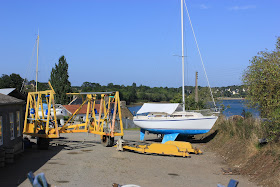In a previous post I highlighted differences in attitudes
towards doing up an old boat. Preservation, Conservation or Renovation. A good
friend and well respected reader and a blogger in his own right, (The Unlikeley Boat Builder) suggested that in my case 'prevarication' might
be more appropriate term. He might as well have said ‘Just get on with it why
don’t you?’. I can take a hint.
So, the last few dry days have been spent taking home every bit of moveable wood from the boat (to sand and treat in relative comfort) and working on the
rubbing strake to try to improve and protect it before the worst of the winter
comes. The original manual for the boat describes the wood as ‘African
Teak’ and further research on the internet suggests that this was a euphemism
for Iroko. According to the internet, it is a teak-like wood but slightly
courser and more brittle.
The rubbing streak was sound but dirty and neglected so I
opted for sanding to begin with and I was pleasantly surprised how little
effort was required to get back to new looking wood. I used a Boch detail
sander for this job with 80 grade sandpaper to get at the worst, followed by 120
grade to smooth it out before applying a preservative.
Firstly a few comments on the Boch. This is my third sander
in as many months – in renovating the house I have used and burned out a Black
and Decker and a McAlister. For the boat therefore I chose to spend a little
more money in the hope that the increased investment would pay off through
longer life. So far so good – although already I’ve had to replace the sanding
pad. Maybe I’m doing something wrong. I’ll keep you posted.
Having got back to clean wood the big question had to be
about the choice of preservative. There is a good deal of literature suggesting
that varnish is not good with teak or teak-like woods. They’re too oily and
varnish won’t adhere, so the argument goes. On the other hand, there seems to
be an equal number of people who advise against oil coatings – according to
them, they don’t last and they don’t produce the mirror like shine you can get
with varnish. Others, long distance voyagers in particular, suggest avoiding all
oils and varnishes in favour of paint which is a much tougher coating. So what
to do? I was especially confused because yet another school of thought suggests
that if you really want to preserve wood you should epoxy it as a kind of GRP
sheathing.
In the end, I decided that for this year at least, I would
use a variety of techniques and then, having found the best one, apply that
technique everywhere ‘as and when’ I had occasion to renew or refresh wooden
parts. SO, for the rubbing strake I have applied a new International Paints
Product known as Woodskin.
According to the literature, it is part wood
sealer, part oil, and, so long as you sand between coats, you can add more
coats whenever required. A can cost me 44 Euros so it had better be good! The
manufacturers say it can be used as a stand-alone product or a base prior to
varnishing. I’ve got two coats on and I’ll varnish before launching. For now
though, I’m pleased to have seen an improvement and to have got some protection
into and onto the wood, which has come up a beautiful honey colour. Not shiny,
but with enough sheen to glow in the winter sunlight.
Seaward


















































